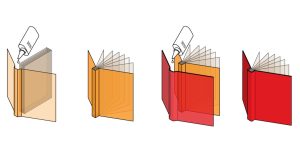You’re probably more familiar with case binding than you realize.
In the world of bookbinding, case binding is a method that is popularly used with hardcover books. Although this method is time consuming and can be expensive, it is also the most durable way to bind books and assures they will hold up to heavy usage. It also exudes a feeling of quality and weight. Read on to find out more about this high end method of book binding.
The Case Binding Process
To better understand case binding, let’s look at what the process entails. The first step is construction of the cover. The cover is made of durable cardboard or lightweight wood, and covered with leather, cloth or vinyl. It is not attached to the pages until the final of the case binding process.
Once the cover has been made, it is time to bind the pages of the book. The process involves arranging the pages in order, then sewing or stitching them together using the Smyth method of sewing. Smyth sewing uses thread to sew through the folds of each section of pages (known as a signature), and then sew the entire book block together. This type of binding is very durable and will allow the book to be opened wide.
Next, trimming occurs. In this step, book blocks – essentially the final book without the cover – are trimmed down to size to match the desired dimensions of the book.
Finally, the gluing process occurs. For this step, the glue is applied to the spine of the book block and a piece of fabric is placed on top of the glue. Then the hardcover case is wrapped around the book block.
Case Binding Use Cases
There are certain books that are better suited for case binding than others. A book should have a thickness of at least 1/8” in order to support case binding, but be no more than 2” thick. If your book is more than 1,000 pages, it may be best to break it up into two volumes, as books of this thickness will cause undo stress on the case binding.
Often dust covers are used on case bound books. These covers wrap around the book and fold inside its covers, but they are not bound in place and, therefore, not part of the binding process.
Because the case binding process is generally more expensive than other binding processes, books that are case bound tend to be more expensive, as well. Depending on the type of project you’re working on, it could be worth the investment to have an impressive looking tome which will withstand the test of time.
Is Case Binding Right for Your Book?
Deciding what type of book binding method is best for your book requires determining the usage and feeling you want to portray with your book. Case binding gives a sense of quality, longevity, weight and stature. If that’s what you’re trying to convey with your book, then case binding might be just perfect for you publication.
If you need some help deciding whether or not this is the right book binding method for you, reach out to contact our print experts for a consultation. They can assist you with all of your binding needs!




